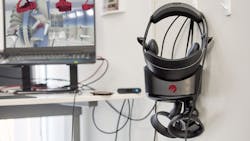A New 3D Approach to Remote Engineering in the Post-Pandemic World
Just one hour of unplanned downtime can cost an organization hundreds of thousands of dollars. But in the post-pandemic world, fixing equipment failures is no longer as simple as flying in an expert to sort things out on the spot.
In fact, most aspects of doing business have now become more complex as organizations have suddenly been forced to adapt to new ways of remote working.
Conferencing services have taken off as a way for remote teams to collaborate on projects when they can't be in the same room. But two-dimensional conferencing is a poor substitute for engineers trying to work together remotely on complex 3D data to design the latest motor vehicle or jet engine.
And trying to untangle complex problems remotely from thousands of miles away is fraught with difficulties—even when using products like Microsoft’s Remote Assist. The expert often has to resort to waving their hands around on a screen to communicate to the technician which part of a machine they should be fixing (and which parts should be left alone).
The COVID-19 pandemic is forcing engineering firms to accelerate their adoption of immersive collaboration solutions to bring their geographically dispersed teams together. Suddenly they have become a business continuity requirement, as the signs are that this “new normal” will be with us for some time.
The challenge lies in taking existing platforms that are not collaborative and extending legacy software to enable it to become immersive—for seamless and secure sharing, in real time, of complex 2D and 3D data across augmented reality (AR), virtual reality (VR), desktop and mobile devices.
The key to enabling true real-time collaboration is to start with the data source and ensure that this single point of “truth” is the same for everybody when working together—no matter where they are located or what device they wish to use. This way, everyone in the team is working from the most correct and up-to-date information available at all times.
Whether it is a CAD package, PLM software, an MRI scanner, robotic simulation software or a laser scanning system, many industries are becoming increasingly dependent on spatial data types and digital twins. These complex data formats are usually incompatible or just too cumbersome to use in existing collaboration platforms such as Zoom, Skype, Teams or Google Hangouts—all built primarily for 2D data formats such as video, text or images.
Moreover, the legacy software generating the data itself is unlikely to have any built-in, real-time collaboration functionality, forcing enterprise users to resort to one of two methods:
- Manually exporting the data, followed by a painful and time-consuming reformatting process, then manually importing the newly crunched data into some type of third-party standalone collaboration package
- Ignoring the spatial nature of the data entirely, instead screen grabbing or rendering out 2D images of the original 3D data for use in a basic PowerPoint presentation or something similar
Neither of these methods allows teams to efficiently collaborate using a live data truth (i.e., the original data itself instead of a reformatted, already out-of-date interpretation of it). So, both methods only compound the root collaboration problem instead of solving it.
Networking Solution
The latest generation of real-time immersive 3D collaboration technology is integrated directly into the host software, grabbing the original data at source before efficiently pushing it into a real-time environment which users can access using their choice of device (VR, AR, desktop, browser or mobile) for instant and intuitive collaboration. End-to-end encryption ensures that even the most sensitive data may be confidently shared across remote locations.
The integration into the host package provides not only a live connection to the data but also a bi-directional connection, which means that users are still connected to the host software package running in the background. All the underlying metadata from the host package is available to the immersive experience; annotations, snapshots, action lists or spatial coordinate changes can be saved back into the host package.
This kind of approach adds a new dimension to problem-solving: Users can share live, complex 3D files such as CAD data, interact with them and reveal “hidden” parts deep within a machine that may be causing an issue. The technology also transforms day-to-day collaboration between remote team members. Design reviews, for example, can be brought to life, with participants walking through a model, no matter where they are in the world—saving time and money in the race for innovation.
Karl Maddix is co-founder and CEO of Masters of Pie.
